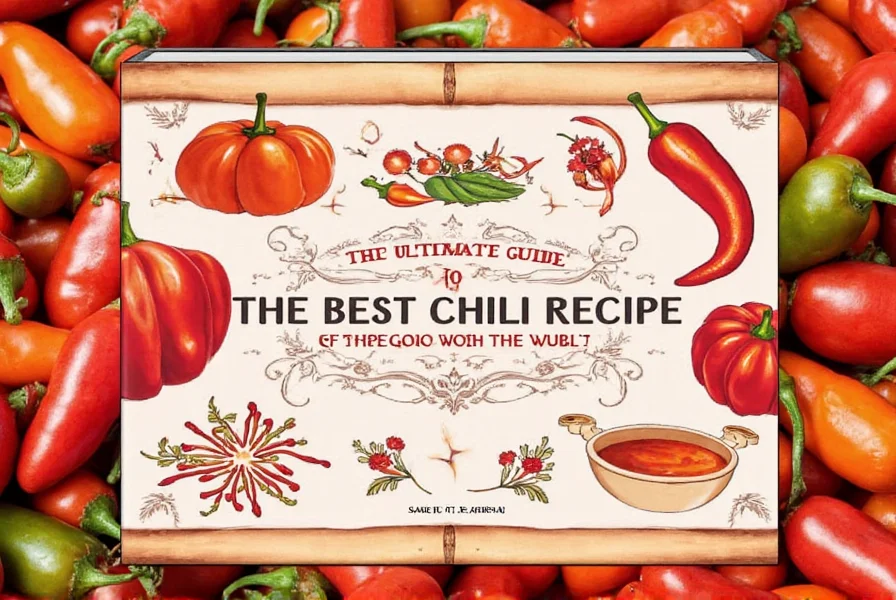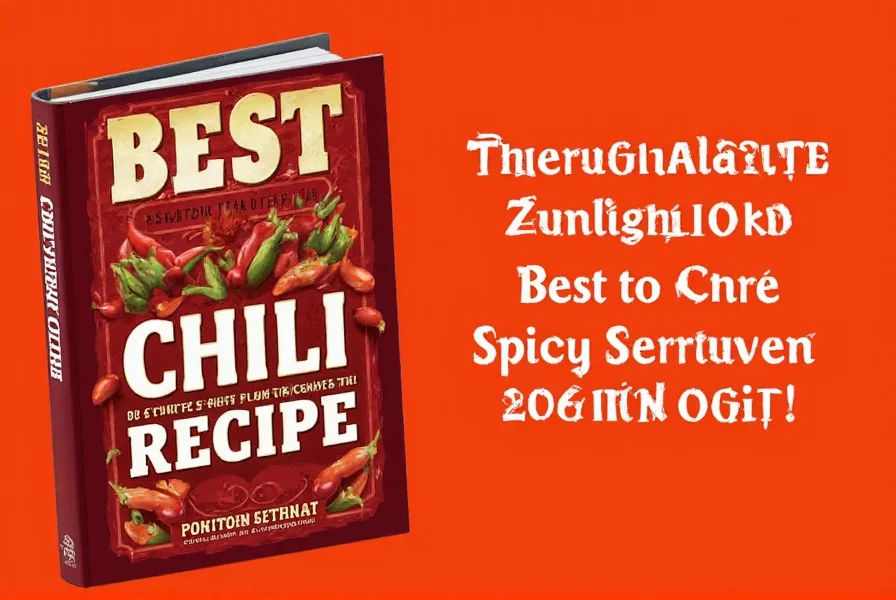The Ultimate Guide to the Best Chili Recipe: Spicy Secrets from Around the World!
Chili—whether you spell it with an 'e' or an 'i', this fiery dish is more than just comfort food. It's a culinary tradition that spans continents, cultures, and centuries. Whether you're a home cook experimenting on a lazy Sunday or a pro chef fine-tuning your restaurant menu, mastering the best chili recipe can take your spice game to the next level.
In this guide, we’ll walk you through global chili traditions, explore variations from Texas to Thailand, and even give you a step-by-step breakdown of what makes a truly unforgettable pot of chili. Plus, you'll get tips on buying the best ingredients, including must-have spices and kitchen tools!
Table of Contents
- Chili Around the World: A Flavorful Journey
- The Best Chili Recipe Ever? Let’s Break It Down
- Spice Blends That Make the Magic Happen
- Buying Guide: Essential Tools & Ingredients
- Common Mistakes (and How to Avoid Them)
- Final Thoughts: Mastering Your Own Signature Chili
Chili Around the World: A Flavorful Journey
While chili as we know it in the U.S. often brings up images of a hearty stew made with beef, beans, tomatoes, and spices, the truth is far richer—and spicier. From Mexican mole sauces to Indian vindaloos, chili peppers have shaped cuisines around the globe. Let's take a look at some standout global chili traditions:
| Region | Signature Chili Dish | Key Spice(s) | Flavor Profile |
|---|---|---|---|
| Mexico | Mole Poblano | Ancho, Mulato, Pasilla | Earthy, Sweet, Complex |
| India | Vindaloo | Kashmiri Chili, Garam Masala | Tangy, Spicy, Savory |
| Thailand | Pad Thai with Chili Paste | Bird’s Eye Chili | Fiery, Salty, Umami |
| Texas, USA | Beef Chili | Cayenne, Smoked Paprika | Rich, Meaty, Smoky |
| China | Sichuan Hot Pot Base | Dried Sichuan Peppercorns, Doubanjiang | Numbing, Spicy, Bold |
Understanding these regional flavors helps us appreciate how chili can be customized for any palate—from smoky and sweet to fiery and fruity. And once you understand the roots, you're ready to craft your own best chili recipe.
The Best Chili Recipe Ever? Let’s Break It Down

What makes a chili the “best”? It comes down to balance. You need depth from slow-cooked aromatics, richness from quality protein (or plant-based alternatives), and heat from the right mix of chilies. Here’s a globally inspired version that hits all the flavor notes:
Ingredients:
- 2 lbs ground beef (or jackfruit for vegan option)
- 1 cup chopped onion
- 4 cloves garlic, minced
- 1 red bell pepper, diced
- 1 can (15 oz) kidney beans
- 1 can (15 oz) crushed tomatoes
- 2 tbsp tomato paste
- 2 tsp smoked paprika
- 1 tsp cumin
- 1 tsp oregano
- 1/2 tsp cayenne (adjust to taste)
- 1 tsp chili powder (preferably New Mexico or Ancho)
- 1 tbsp Worcestershire sauce
- 1 tbsp balsamic vinegar
- Salt and black pepper to taste
- 1 tbsp olive oil
Instructions:
- Heat olive oil in a large pot over medium-high heat. Add onions and sauté until translucent (about 5 minutes).
- Add garlic and bell pepper, stirring occasionally for another 3–4 minutes.
- Add ground beef and cook until browned and crumbly. Drain excess fat if needed.
- Stir in tomato paste and let it toast slightly for about 2 minutes—this deepens the flavor.
- Add crushed tomatoes, beans, and all the spices. Stir well to combine.
- Bring to a boil, then reduce to low and simmer uncovered for 60–90 minutes, stirring occasionally.
- Stir in Worcestershire sauce and balsamic vinegar before serving.
This base can be adjusted infinitely depending on your tastes and preferences. Want something sweeter? Try adding a splash of molasses or cocoa powder. Prefer extra heat? Toss in fresh serrano slices or a spoonful of harissa paste.
Spice Blends That Make the Magic Happen
Spices are the soul of any great chili. Here’s a cheat sheet to help you choose the right ones based on flavor profiles:
| Spice | Flavor Note | Best For | Heat Level |
|---|---|---|---|
| Smoked Paprika | Earthy, woodsy | Adding depth and smokiness | Low |
| Cumin | Earmthy, nutty | Building warmth and aroma | None |
| Cayenne | Pungent, sharp | Boosting overall heat | High |
| Oregano | Herbal, minty | Adding herbal brightness | None |
| Chili Powder | Varies by blend | Main flavor backbone | Moderate |
| Ancho Powder | Fruity, raisiny | Adding sweetness and mild heat | Low-Moderate |
| Gochugaru | Sweet, smoky, spicy | Korean-style chili or fusion dishes | Moderate-High |
If you're feeling adventurous, try making your own homemade chili powder using dried chilies, toasted cumin seeds, and garlic powder. The difference in flavor between store-bought and freshly ground is night and day!
Buying Guide: Essential Tools & Ingredients
To nail your chili every time, invest in a few key items that elevate both prep and flavor development. Here's a list of recommended gear and ingredients:
Must-Have Kitchen Tools
- Heavy-Bottom Dutch Oven: Retains heat well and ensures even cooking.
- Microplane Grater: Perfect for grating garlic or fresh ginger into your chili.
- Cast Iron Skillet: Great for searing meat before adding to the pot.
- Immersion Blender: For blending part of the chili into a smoother texture without transferring hot liquids.
- Spice Grinder: If you want to make your own spice blends from whole seeds and dried chilies.

Top Chili Ingredients to Keep in Your Pantry
- Canned Crushed Tomatoes: Rich and slightly acidic, perfect for body and flavor.
- Kidney Beans: Adds texture and heartiness.
- Tomato Paste: Intensifies umami and gives chili a deeper color.
- Chipotle in Adobo: Smoky, spicy, and packed with flavor—use sparingly.
- Cocoa Powder: Enhances earthiness and balances acidity in chili.
- Liquid Smoke: Adds smokiness without needing a smoker or grill.
Common Mistakes (and How to Avoid Them)
Even seasoned cooks can fall into chili traps. Here are the top mistakes and how to avoid them:
| Mistake | Why It Happens | How to Fix It |
|---|---|---|
| Overcooking | Leads to mushy beans and broken-down vegetables | Add beans later in the cooking process; simmer gently |
| Bland Taste | Lack of salt or under-toasted spices | Taste as you go and toast spices in oil first |
| Too Watery | Excess moisture from canned ingredients | Simmer longer or use less liquid initially |
| Over-Spiciness | Too much chili powder or cayenne | Add dairy (like sour cream) or acid (lime juice) to mellow heat |
| Burning the Bottom | Not stirring frequently or heat too high | Use medium-low heat and stir regularly |
Final Thoughts: Mastering Your Own Signature Chili

There is no single “best chili recipe”—because the best one is the one you love most. Whether you prefer yours lean and spicy like Texas-style or rich and complex like a Mexican mole, there’s room in the world of chili for creativity, personal flair, and a bit of trial and error.
So grab your favorite spices, experiment with different proteins and textures, and don’t be afraid to push the boundaries of tradition. With the tips in this guide, you’re well on your way to crafting your own legendary bowl of chili—one that tells your story through every smoky, spicy bite.
And remember: chili isn't just a meal—it's a conversation starter, a crowd pleaser, and a love letter to global spice traditions.











 浙公网安备
33010002000092号
浙公网安备
33010002000092号 浙B2-20120091-4
浙B2-20120091-4